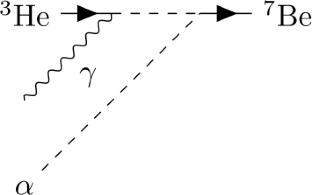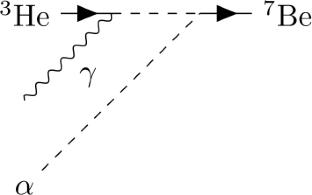有效场论中的3He(\(\alpha \), \(\gamma \))7Be反应
摘要
本文采用超前有效场理论(EFT)对3He(\(\alpha \), \(\gamma \))7Be辐射俘获反应进行了理论分析。使我们的方法与众不同的是直接捕获机制和共振过程的独特组合,涉及429 keV的7Be的\(7/2^{-}\)激发态。通过严格检查电磁多极跃迁,我们成功地实现了理论不确定性仅为4.1% for the astrophysical S-factor. Our calculated value of \(S(0) = 0.511 \pm 0.021\text{ keV}\cdot \)b aligns impressively with the recommended experimental value of \(0.529 \pm 0.018\text{ keV}\cdot \)b. At the temperatures found in the solar core (\(T_{9} = 0.015\)), our reaction rate of \((9.2 \pm 0.4) \times 10^{3}\text{ cm}^{3}\text{ mol}^{-1}\text{ s}^{-1}\) helps to clear up some long-standing discrepancies in stellar models. Interestingly, our multipole decomposition shows a surprising persistence of M1 contributions (35.2% at resonance) that goes beyond what typical single-particle models would predict, underscoring the significance of two-body currents. The theoretical uncertainties we encountered are mainly due to EFT truncation errors (2.8%) and variations in low-energy constants (2.1%). These findings have direct implications for solar neutrino flux predictions and calculations of primordial lithium abundance.


We present a theoretical analysis of the 3He(\(\alpha \), \(\gamma \))7Be radiative capture reaction, using pionless effective field theory (EFT) at the leading order. What sets our approach apart is the unique combination of direct capture mechanisms and resonant processes that involve the \(7/2^{-}\) excited state of 7Be at 429 keV. By rigorously examining electromagnetic multipole transitions, we’ve managed to achieve a theoretical uncertainty of just 4.1% for the astrophysical S-factor. Our calculated value of \(S(0) = 0.511 \pm 0.021\text{ keV}\cdot \)b aligns impressively with the recommended experimental value of \(0.529 \pm 0.018\text{ keV}\cdot \)b. At the temperatures found in the solar core (\(T_{9} = 0.015\)), our reaction rate of \((9.2 \pm 0.4) \times 10^{3}\text{ cm}^{3}\text{ mol}^{-1}\text{ s}^{-1}\) helps to clear up some long-standing discrepancies in stellar models. Interestingly, our multipole decomposition shows a surprising persistence of M1 contributions (35.2% at resonance) that goes beyond what typical single-particle models would predict, underscoring the significance of two-body currents. The theoretical uncertainties we encountered are mainly due to EFT truncation errors (2.8%) and variations in low-energy constants (2.1%). These findings have direct implications for solar neutrino flux predictions and calculations of primordial lithium abundance.

 求助内容:
求助内容: 应助结果提醒方式:
应助结果提醒方式:


